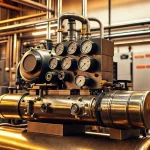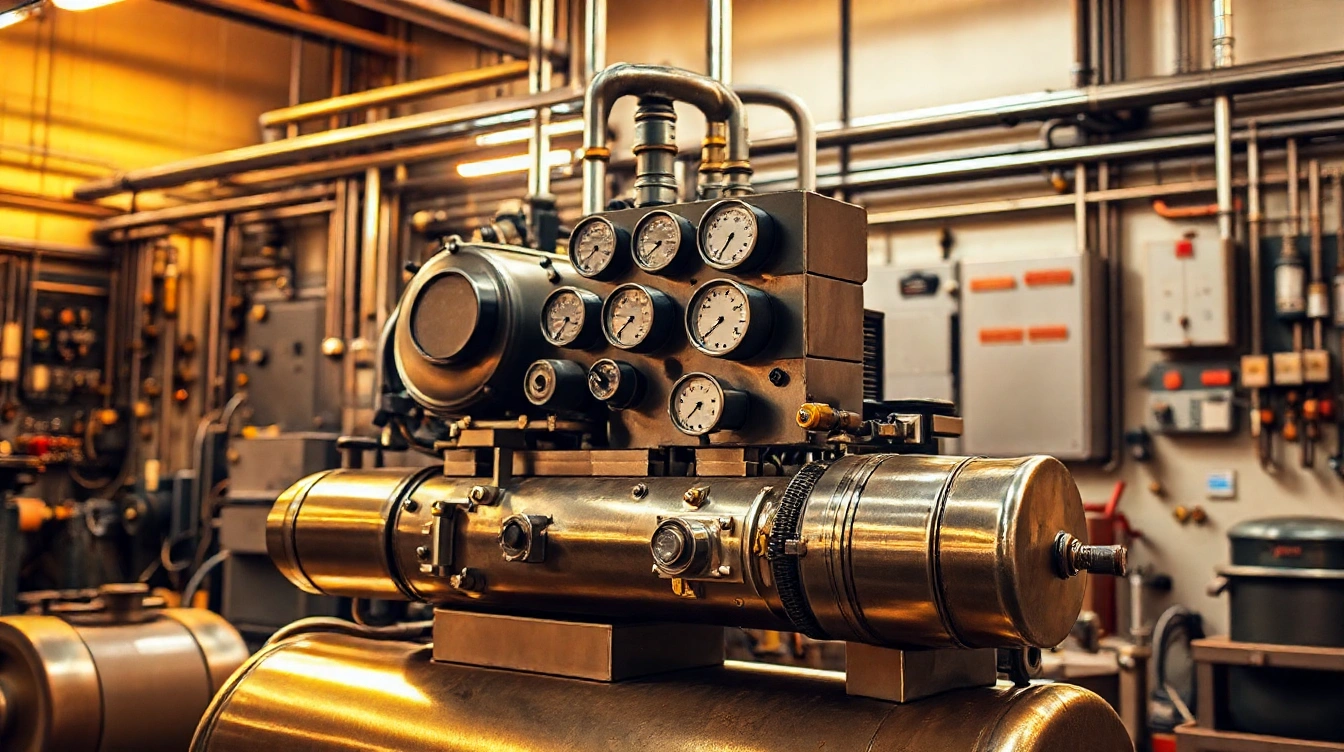Mastering industrial air compressor setups demands more than basic knowledge. Selecting the right size, preparing the site precisely, and configuring system components adaptively are key to peak performance. Combining expert tuning with diligent maintenance not only boosts reliability but also cuts operational costs. Understanding common pitfalls and adhering to safety protocols ensures smooth and efficient operation. This guide offers actionable insights to optimize every stage from installation to troubleshooting helping professionals build compressor systems that deliver lasting, energy-efficient results.
Essential steps for successful industrial air compressor setup
Setting up an industrial air compressor installation requires careful planning and execution to ensure efficient and reliable operation. The first critical step is preparing the installation site for optimal compressor performance. This means selecting a well-ventilated area with adequate space for the compressor system setup and easy access for maintenance. Additionally, the flooring should be sturdy enough to support the weight of the compressor, and vibration isolation pads are recommended to reduce noise and mechanical stress.
Also to discover : How can UK startups build a strong brand identity in a competitive market?
Selecting the right compressor size and configuration is fundamental to meet the specific air demand without causing inefficiencies or undersizing the system. The selection process should consider the volume of air required, operating pressure, and duty cycle. Consulting the setup checklist can help avoid common pitfalls such as choosing an oversized compressor that wastes energy or an undersized one that cannot keep up with demand. It’s also important to decide between different compressor types such as rotary screw or reciprocating depending on the application and operating environment.
The final step in a thorough compressor system setup involves establishing proper airflow pathways and integrating system components correctly. Piping should be arranged to minimize pressure drops and avoid sharp bends that restrict airflow. Installing appropriate filters, dryers, and regulators ensures clean, dry air and stable pressure, protecting downstream equipment from damage. A well-executed industrial air compressor installation benefits from following a comprehensive setup checklist to confirm each aspect is addressed, including electrical connections and safety devices. For a detailed guide on implementing these steps correctly, reviewing resources on industrial air compressor installation can be highly beneficial.
This might interest you : Effortless steps for successful industrial air compressor installation
Best practices for configuring and tuning compressor systems
Optimizing compressor configuration is essential for enhancing efficiency and reliability in industrial settings. Proper system tuning begins with adjusting pressure settings to match the specific operational demand. Setting pressure too high wastes energy, while too low affects performance. Use precision instruments to calibrate pressure and flow controls carefully, ensuring they align with the required output parameters.
Integrating dryer and filtration systems into the compressor setup is another crucial step. These components maintain air quality by removing moisture and contaminants, which can otherwise reduce system life and cause operational issues. Choosing compatible dryers and filters tailored to your compressor type helps maintain optimal air purity and prevents corrosion or damage to downstream equipment.
Employing monitoring tools for real-time adjustments is a forward-thinking approach to system tuning. Sensors and digital controllers provide continuous data on pressure, temperature, and flow rates, enabling operators to fine-tune parameters dynamically. This proactive monitoring supports industrial compressor optimization by preventing downtime, anticipating maintenance needs, and improving energy consumption.
Maintenance strategies to maximise performance and reliability
Regular air compressor maintenance is essential for achieving optimal uptime improvement and extending the lifespan of your equipment. Establishing a preventive maintenance schedule ensures potential issues are identified before they escalate into costly failures, directly supporting continuous operation.
Key inspection points during routine maintenance include checking the filters, lubrication systems, and belts. Filters must be cleaned or replaced regularly to maintain air quality and prevent strain on the compressor. Proper lubrication reduces friction and wear, safeguarding moving parts, while timely belt inspections help detect cracks or slackness that impair efficiency.
Additionally, upgrading or replacing worn system components enhances overall performance. Components that show signs of degradation not only increase energy consumption but also raise the risk of breakdowns. By proactively addressing these parts, companies can secure maximum reliability, minimizing downtime.
For specialized guidance tailored to heavy-duty environments, consulting resources on industrial air compressor installation can further inform maintenance practices to suit complex systems.
Reducing energy consumption and boosting operational efficiency
Improving compressor energy efficiency is essential for cutting down energy use and reducing operating costs in industrial settings. One of the most effective methods is implementing variable speed drives (VSDs) and smart controls. VSDs adjust the compressor’s motor speed based on actual demand rather than running at constant full speed, preventing unnecessary energy waste. Smart controls further optimise compressor operation by monitoring performance in real-time and adjusting settings to maintain efficiency under varying workloads.
Leaks in the air distribution network significantly diminish efficiency. Minimising leaks through regular inspections and timely repairs is critical to maintaining system integrity and lowering energy consumption. Even small leaks can lead to substantial energy losses over time, so establishing a proactive maintenance routine ensures sustained savings.
Another way to boost operational efficiency is by leveraging heat recovery systems. These systems capture the heat generated by compressors—often wasted during operation—and repurpose it for facility heating or other processes. This dual use of energy not only conserves resources but also lowers overall production costs.
For businesses exploring upgrades or new setups, following best practices in industrial air compressor installation can further enhance energy efficiency and reliability. Proper installation impacts all aspects of operation, from energy consumption to maintenance needs. Developing an energy-conscious strategy combining smart control technology, stringent leak management, and heat recovery maximises productivity while significantly lowering energy bills.
Avoiding common setup and operational mistakes
Setting up an air compressor requires careful attention to prevent common air compressor errors that can lead to reduced efficiency or premature equipment failure. One of the most frequent setup mistakes is overlooking the system’s actual pressure requirements or choosing a compressor with insufficient capacity. This mismatch can cause the compressor to run continuously or operate under strain, impacting both performance and lifespan.
Another critical yet often ignored issue is inadequate ventilation or improper placement during the industrial air compressor installation. Compressors need sufficient airflow to dissipate heat. Without proper ventilation, the unit can overheat, triggering automatic shutdowns or damaging internal components.
Operational pitfalls also arise when calibration and maintenance checks are neglected. Regularly calibrating pressure gauges and monitoring system parameters ensure the compressor functions within specified tolerances. Failing to perform these checks may result in inaccurate pressure delivery, increased energy consumption, or safety hazards.
By understanding these common causes of setup and operational failures, operators can take proactive steps such as verifying system requirements, ensuring optimal installation conditions, and maintaining a regular inspection schedule. For those embarking on installation projects, reviewing detailed guides on industrial air compressor installation can provide valuable insights to avoid these pitfalls effectively.
Safety protocols and compliance in compressor operations
Ensuring compressor safety is paramount in any industrial setting. Operators must prioritize compliance with established compliance standards to maintain a safe working environment and prevent accidents. The first essential step involves the consistent use of personal protective equipment (PPE), such as gloves, eye protection, and ear defenders, to reduce exposure to potential hazards associated with compressor operations.
Hazard awareness training is equally critical. Workers should be educated about risks linked to high-pressure air systems, including sudden pressure releases or mechanical failures. Understanding these risks fosters vigilance and proactive behavior to avoid unsafe situations.
Adhering to electrical and pressure safety codes is another cornerstone of workplace safety. This means ensuring all wiring, controls, and pressure vessels meet national and local regulations. Compliance with these codes minimizes the likelihood of electrical faults and overpressure events that could lead to dangerous failures.
Moreover, developing clear emergency response and maintenance shutdown procedures is vital. These protocols guide operators on how to react swiftly and safely if a malfunction occurs, reducing the risk of injury and equipment damage. Regular drills and proper documentation of these procedures further strengthen the plant’s preparedness.
Adopting a thorough approach to compressor safety aligns with best practices and legal requirements, making it an indispensable aspect of industrial operations. For a deeper dive into standards and efficient implementation, consulting resources on industrial air compressor installation can be highly beneficial.
Troubleshooting tips and addressing performance issues
When facing compressor troubleshooting, recognizing early signs of malfunction or inefficiency is crucial. Common indicators include unusual noises, decreased pressure output, frequent cycling, or elevated operating temperatures. These symptoms often signal underlying issues that require prompt attention to prevent costly system repairs.
A systematic approach to problem diagnosis enhances efficiency. Start by checking the power supply and ensuring all electrical connections are secure. Next, inspect intake filters and valves for blockages or damage, as these components directly impact performance. Monitoring pressure gauges and temperature readings helps identify leaks or overheating conditions. Detailed observation and documentation during this process can pinpoint specific faults, facilitating targeted repairs.
Knowing when to escalate to manufacturer support or experienced technicians is vital. For complex issues beyond routine maintenance or when safety concerns arise, professional assistance ensures accurate resolution and preserves system integrity. Moreover, working with experts familiar with industrial standards improves long-term reliability.
For those involved in industrial settings, following best practices for industrial air compressor installation can reduce troubleshooting frequency. Proper installation limits wear and operational stress, thereby minimizing the need for extensive system repairs. This proactive step ultimately contributes to sustained compressor performance.
Recommended tools, accessories, and resources for effective setups
To ensure a successful industrial air compressor installation, having the right compressor tools and recommended accessories is crucial. Essential tools typically include torque wrenches, pressure gauges, and pipe threading equipment. These allow precise assembly and secure connections, reducing the risk of leaks or failures during operation.
Beyond the basics, certain accessories can significantly enhance performance and longevity. For instance, vibration isolators help reduce noise and wear, while advanced filtration units improve air quality and system reliability. Investing in upgraded control panels or remote monitoring devices also simplifies maintenance and optimizes compressor output.
Access to comprehensive support resources such as technical manuals, wiring diagrams, and detailed installation guides is equally important. These materials provide step-by-step instructions and troubleshooting tips that can prevent costly errors. Additionally, many manufacturers offer online training or webinars, which deepen understanding of both installation processes and routine upkeep.
In summary, a combination of well-chosen tools, recommended accessories, and thorough support resources forms the foundation for an effective industrial air compressor installation. For detailed, step-by-step guidance specifically tailored to industrial systems, consider consulting specialized resources on industrial air compressor installation.











